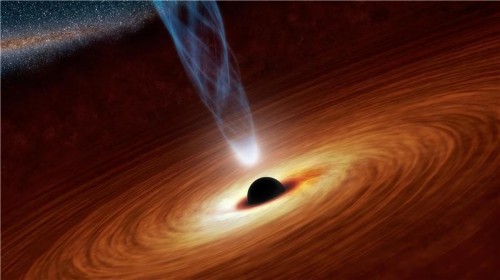Astronomers speculate that many galaxies could have been more massive and contained more stars than they actually do. The scientists proposed two main mechanisms that might slow or stop the process of mass growth and star formation but could not choose between them. New data show that it's the fault of black holes spewing gas that would otherwise be raw material for star formation

A radio telescope image of galaxy 4C12.50 which is about 1.5 billion light years from Earth. The diagram shows the location details at the edge of a fast jet of particles, where the huge cloud of gas (in yellow-orange colors) is pushed by the jet. Figure: Morganti et al., NRAO/AUI/NSF)
The question of why the galaxies are not getting bigger has long been a mystery to astronomers as well as other important questions such as what is the factor that regulates the rate of star formation in galaxies and what keeps them from being filled with more stars than there are? Researchers using a network of radio telescopes observed one of the processes that was on the suspect list: jets from a massive black hole throwing a huge amount of material, which could have been used to form new stars, out of the galaxy.
Astronomers speculate that many galaxies could have been more massive and contained more stars than they actually do. The scientists proposed two main mechanisms that might slow or stop the process of mass growth and star formation - violent stellar winds from the explosions of fresh stars, and thrust from the jets powered by the massive black hole at the center of the galaxy.
"Using detailed images taken by an intercontinental combination of radio telescopes, we were able to see the massive clumps of cold gas being pushed out of the centers of galaxies by jets driven by the black hole," says Raffaella Morganti of the Netherlands Institute for Radio Astronomy at the University of Groningen.
The scientists specifically studied a galaxy called 4C12.50, which is about 1.5 billion light-years away from Earth. They chose this galaxy because it is at a stage where the black hole "engine" that produces the jets has just begun to operate. When the black hole - a concentration of mass so compressed that even light cannot escape from it - attracts matter, the matter forms a disk that spins around the black hole. The processes at the edge of the disk create strong gravitational energy and cause the black hole to shoot material out from the poles of the disk.
At the ends of the two jets, the researchers found clumps of hydrogen gas moving out of the galaxy at a speed of a thousand kilometers per second. The mass of one of the gas clouds blown from the center of the galaxy is 16 thousand times that of the sun, while the second jet is even more massive - it contains gas and dust with a mass 140 thousand times greater than the mass of the sun. The size of this cloud is about 160 by 190 light years.
"This is the most definitive evidence yet for the interaction between the fast jets in this type of galaxy and the dense interstellar cloud." Morganti says. "We believe that we see in action a process in which an active internal engine can remove gas - the raw material for star formation - from young galaxies." she added.
The researchers published their findings in the September 7 issue of the journal Science.

3 תגובות
It is possible that my response is not important and necessary for the concept, I would appreciate a response if it interferes with the matter.
A radio image of the galaxy 4c12.50. In my humble opinion, it shows the movement of the rotation of the galaxy in contrast to the movement of the gas jet, that is, the movement of the jet exiting the loops is completely opposite to the expected direction.
Our universe is very sensitive to such things. If for some reason the laws of nature were different so that this phenomenon would not occur, everything would be very different.